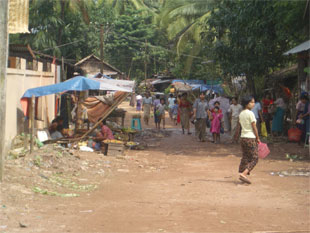Semester at
Sea Fall
2006 Voyage 
- Home Page
- My Bio
- Comparative Global
Cities Project: From Slums to Starbucks
- The Japanese City: Modern and
Traditional
- Vietnam: Vernacular at Heart
- Myanmar: Poor in Wealth; Rich in Culture
- India: A World of Contradictions
- Egypt: Cairo: A Globalizing City
- Spain: Madrid: Old Beauty Mixed
with Modernity
- Open Letter
Myanmar: Poor in Wealth; Rich in
Culture
Before the MV Explorer docked in the country of
Myanmar, I
felt as if I had been briefed, fairly extensively, about the amount of
poverty
to be found in this particular country. As
a result I tried to picture in my mind how Myanmar
would look in
contrast to the other countries that I had been fortunate enough to
visit. Unfortunately, I soon learned that
nothing
could really prepare a person to witness the type of poverty that
existed in
the Myanmar capital city of Myanmar, Yangon.

At a first glance the city of Yangon seemed to be an urban space that was also a very vernacular space. I found thousands of people squatting on the city’s busiest streets trying to sell anything they possibly could, from old cassette tapes to chewing tobacco. From what I could gather from the local people and my tour guide there was only one shopping mall in the entire capital city, meaning that most western fashion and many other global products were not available to the Burmese people. In fact, most Burmese urbanites still wore the traditional Burmese longgi. Products that have become everyday needs in many global societies such as, cell phones, cars, compact discs, and cameras are still very unaffordable and rare in Myanmar.
However, though Yangon is very far from becoming a global city it has recently opened up to foreign investment. This means that big, western style hotels are now becoming part of Yangon. This shows that the global phenomenon of tourism is slowly coming to Yangon, which means that the global culture of tourism will also be coming into the city.
One reason why Myanmar is only now opening its borders to foreign investment is because the Myanmar government is a military regime, which regulates all outside influence. The military has had the power to shape Yangon in all ways, not just economically. In fact, Donald Seekins wrote in his article entitled, The State and the City: 1988 and the Transformation of Rangoon, that the Myanmar government has removed between 450,000 to 500,000 people from their homes in Yangon and forced these people to move to the outskirts of town. Unfortunately, not only were these people forced to leave their city homes, but many times the new housing establishments did not even have basic living needs.
In closing, Yangon is a very poor, sheltered, and vernacular city, but it is also a city that is very rich in culture, and tradition, a trait that is becoming harder to find with the spread of globalization. Unfortunately, one reason why the cities of Myanmar have the ability to stay rich in their own culture is because the military regime government has (up until recently) kept out all foreign investment, and has had the ability to shape Yangon in whichever manner it wishes. For about 500,000 displaced Burmese people this type of government has hurt their urban lives.